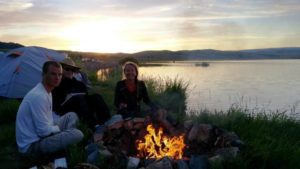 One of my absolute favorite parts of this journey so far is the unbelievable people we’re meeting along the way. From ranchers to activists, coal mine employees to former Peace Corps members and even a few uncles.
One of my absolute favorite parts of this journey so far is the unbelievable people we’re meeting along the way. From ranchers to activists, coal mine employees to former Peace Corps members and even a few uncles.
We met an unbelievably generous couple in Roundup who have lived their lives as artists and writers, but also organized “The New Western Energy Show” back in 1976. The circus-style event combined live entertainment with renewable energy information and demonstrations, spreading the ideas of sustainability throughout Montana in an impressionable time for new ideas.
Outside of Billings, MT, we stayed with a man who lived a simple life as a cattle rancher from the surface but has also worked tirelessly for years with his family to implement laws that prohibit more coal mining in the Bull Mountains. The Northern Plains Resource Council, one of the organizations created to help stop the mining, got the Good Neighbor Agreement to pass in the state. The stipulations of the agreement help to keep the dialogue between mining industries and homeowners open; mines are required to consult local organizations and community members before taking action within that local area. It is used as a model in many states today and has made serious strides to strengthen community involvement in fossil fuel mining and practices.
Each person we have met or stayed with, however brief or extensive, well-prepared or impromptu, has given us the chance to see how average citizens can impact the energy landscape for all.
Jean Wallace, who lives right outside of Ryegate, MT was the first person who made me realize how much of an impact anyone can make. Though Jean worked as a guidance counselor her whole life, a field unrelated to energy, she recognized that Montana’s reliance on coal was destroying more natural land each year and that there was untapped renewable resource potential throughout the state. She and her husband took matters into their own hands and built a passive solar home (a house built halfway underground which utilizes the natural heat and light from the sun) and installed photovoltaic solar panels and a wind turbine to power their home. This allows them to utilize the full energy potential of the sun and wind currents as well as the heat and light that comes pouring in from the sun through large windows in the house.
The concept of passive solar architecture allows homes to collect and store solar energy in the form of heat in colder months, and reject solar heat in the summer, while also allowing natural light to be utilized best to reduce the need for electricity during daylight hours. Jean and her husband built their home south facing to take full advantage of the capability of the sun and partially underground to best hold heat and/or allow the building to stay cool, when needed. This is a technique that has been utilized for thousands of years out of necessity, before the invention of mechanical heating and cooling.
While adopting the use of ‘passive solar’, Jean also takes 27.72KW/h of energy actively from her solar panels. The Alternative Energy Resources Organization (AERO) in their Blueprint for Homegrown Energy Self-Reliance stated “local control is what photovoltaic technology is all about…community to community and household to household”.
This is easier said than done for someone like Jean, whose nearest neighbors are miles away and community based solar is harder to achieve. Because this is an obstacle, Jean puts her excess clean energy back into the grid for use by other energy customers, while also being able to draw energy from the grid when she needs it, in a process of net-metering. Other ways to contribute to clean, renewable energy production is through community based, crowd-funded solar projects. These companies, Mosaic being just one we recently read about, allow investors without their own ability to produce energy, be part of renewable energy projects.
Beyond her home, which she graciously opened to six sweaty bikers, Jean has spent a large majority of her life volunteering for climate change awareness, education and remediation. When we stayed with her, she had most recently returned from a climate change walk and fundraiser in Jamaica. She loves kids, gets through to them well and believes that children are the best hope we have for a better environment. As often as she can, she volunteers educating children, and all ages of people in countries experiencing environmental degradation, of what is happening, why it is happening, and what can be done.
Jean’s profession was not related to energy, nor is her additional environmental work paid or required of her. Building her home was partly for economic benefit, but mostly because she believed it made sense and was beneficial to her state. Community based solar projects are opening up opportunities for citizens without access or experience in renewable energy to be a part of it. Even small things like opening ones home to students on a mission to gain more knowledge of how they can influence the world can make a huge impact. People like Jean, and all the other people we’ve met who surprised us in their devotion to a cause seemingly foreign to them, have inspired us to make a difference and do what we can. No one expects more than that from us, so we should begin by expecting more from ourselves, every day. This course will carry with us these concepts and values and hopefully spread to people we build relationships with far into the future.